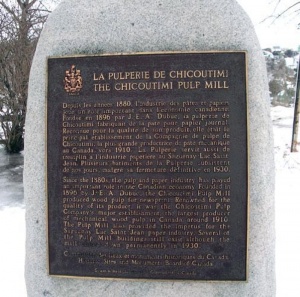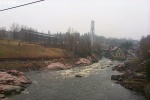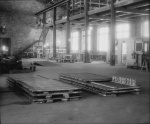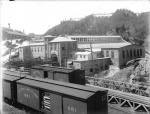Chicoutimi Pulp Mill
par Gagnon, Gaston
A treasure among Quebec's cultural heritage assets, the Pulperie de Chicoutimi [Pulp Mill] is without a doubt one of the province's unique sites. The mill is a rare example of mechanical [rather than chemical] pulping process used in the early days of the region's pulp wood industry. For this reason, in 1983, both the federal and provincial governments granted the site historical monument status, largely as a result of public efforts to see the site granted official recognition. In true French architectural tradition, the mill is built of natural stone, a beautiful and durable choice of materials. Archives document how over several generations site has been put to multiple uses reveal; not only do they describe the day-to-day activities at the location, but also how the mill was built, how it changed hands and how it was transformed into a museum for cultural and touristic purposes.
Article disponible en français : Pulperie de Chicoutimi
Site Museum and Hydroelectric Complex
The pulp mill is located within the city limits of Saguenay, in the former town of Chicoutimi on the east bank of the Rivière Chicoutimi, one kilometre [0.6miles] upstream from where it flows into the Saguenay River. The site covers about thirty hectares [74 acres] in the heart of the du Bassin sector of Chicoutimi. Built on uneven terrain, the mill is surrounded by groves of conifers. The river's fast current and substantial hydraulic potential is largely due to the area's rugged landscape, a factor that makes it particularly suitable for powering a pulp mill.
The pulp mill was built by two companies, La Compagnie de Pulpe de Chicoutimi (CPC), (1896-1924) and Eastern Mining and Smelting (EMS) (1954-1958), which were largely responsible for developing the site's layout and forging the region's characteristic flair. The only remaining tangible vestiges of the CPC era are the hydraulic works, four mills, an electric substation, repair shop and smelter. Even though many of the buildings connected to the plant (saw mill, bark strippers, and administrative offices) have since disappeared, along with the mechanical equipment (turbines, defibrator and hydraulic presses), many of the still-intact structures make it possible understand the production process. As for the remains of EMS, the most visible traces of the former operation are the viaduct at the entrance of the site, a smoke stack, and a hydroelectric station, which has been in operation since 1957.
The dual function of the site, as both a museum and hydroelectric complex, give Pulperie de Chicoutimi added value. Ownership of the site is shared by the City of Saguenay, the Corporation du Musée du Saguenay-Lac-Saint-Jean and the company Elkem Metal, which has been operating the hydroelectric station since 1984. The Corporation has a mandate to restore and preserve the premises and to provide interpretive information and activities. This is in addition to running the museum, which has been located in the old workshop since 2002. Visitors can view expositions such as that of the famous Arthur-Villeneuve house before taking the guided tour. The tour, which includes twelve stations, ends at the mill built in 1912, where shows have been presented since 1980.
An Industrial Landscape
Despite the fact that the pulp and paper industry shaped the development of many regions of the Province of Quebec, the most of Quebec's archaeological sites do not adequately deal with the industry's tangible legacy. The fact that there are so few heritage sites from the pulp and paper industry adds to the distinct nature and importance of the Pulperie de Chicoutimi.
Often associated with the news print era, La Pulperie constitutes not only a veritable technical laboratory but also a social and economic showcase for one of the most active periods in the history of the Quebec pulp and paper industry. The outdoor interpretative tour circuit enables visitors to fully appreciate the museum's displays, which can be divided into three main thematic topics:
1) The river as an industrial location;
2) The link between the renovation of the site and the growth of local markets and
3) The architectural style and size of the buildings as an indicator of the former operation's symbolic importance.
The natural characteristics of the river itself are the reason the site was chosen. Not only did its more than 25,000 horse-power hydraulic capacity meet the technical requirements of the industry, but its flow rate could be regulated upstream at Lac Kénogami by means of a dam and a reservoir. This ensured continuous electrical output year-round. What is more, the hydraulic power could even provide electricity to the site and to the city itself.
This energy-producing capacity which is largely due to the region's geological featrues, allowed the Pulperie de Chicoutimi to distinguish itself from its competitors. Engineers from various origins including Germany, Sweden, Norway, the United States, English Canada and Quebec, were hired between 1897 and 1922 to design and build the establishment with the help of local labourers and contractors. The company brought in professionals and equipment from all over the world. This is proof of the operation's high level of integration within the vast global network of the pulp and paper market. As a result, the Pulperie de Chicoutimi was able to operate at the cutting edge the era's technology. The operation's superior equipment and infrastructures, which were built from a variety of materials such as wood, stone, concrete and steel are proof that the pulp mill was an industry leader.
This location also had many other advantages. It had access to dense spruce forests upstream and downstream from the mills. Spruce was considered the optimal tree species for making the best wood pulp in the industry. In addition, a granite quarry located close made constructing natural stone buildings quite feasible, thereby giving the building its characteristic architectural features so typical of the region. Stone was favoured over brick because "the builders wanted their legacy to outlast them." The fact that the Pulperie de Chicoutimi was located in a working class area made it possible for the company to take advantage of an abundance of labourers, which were already present in the region because of the logging industry. When the mill opened, many workers were already in search of jobs, due to the closing of the large sawmill owned by the Price Brothers' Company. Last but not least, the location was in close proximity to the Saguenay River waterway and a railway line that linked it to Quebec City. These were essential transportation services for sending wood pulp to market.
The on-site interpretative features enable attentive visitors to become familiar with the principles of the pulp production used in the location's former operations. At the same time, the Chicoutimi pulp mill tells the story of the economic fortunes [and misfortunes] linked to the boom in the newsprint papermarket at the turn of the 19th and 20th centuries.
A Developing Industry Financed by Expanding Markets
The growth of newsprint markets in England, France and New York state are at the origin of the construction of the Pulpurie de Chicoutimi's four mills: in 1898, No 1 was built and then No 2 (1903), No 3 (1912) and No 4 (1922). The latter constructed as an extension of the former, Mills 1 and 3 are located at the lower end of the site, where the first hydroelectric plant in Saguenay was established by the Compagnie Électrique de Chicoutimi. Mills 2 and 4 were built at the upper end of the site. Contrary to the first three mills, which were powered by hydraulic power, Mill 4 was run on electricity ,a technological innovation that was developed through expertise of the operation's engineers. This accomplishment is a demonstration of the Pulperiede Chicoutimi's ability to adapt and change with the times.
Industrial Cathedrals
The Pulperie de Chicoutimi was a veritable industrial complex, integrated and self-sufficient. With its electrical substation powered by the hydro-electricpower plant in Pont Arnaud (1913) and its mechanical repair workshop and smelter (1921), the company entrusted the development of its facilities to experienced architects.
C.E. Eaton was the first to be hired to design the Saint-Joseph Mill (No 1). However, it was René P. Lemay, with his vast experience with the Kretz & Tishart Agency in Saint Paul Minnesota, who designed and developed the monumental architectural features that came to be associated with the Pulperiede Chicoutimi. The Sainte-Marie Mill (No 2), built at a cost of 1.5 million dollars, is a testament to the American influence that characterised Lemay's work. Typical of the industrial architecture of the times, with its voluminous right angles made from cinder-block, round-arched windows, and Dutch curved gables, the building added to the prestige of the premises in the manner of a cathedral. This style was again used for the 1912 mill by Lemay himself and again by Lavoie (another engineer) in constructing the workshop. This style contributes greatly to the identity, unity and symbolic strength of the premises.
New Jobs, Houses and Stores
Besides being one of the region's main architectural wonder's, the site, with its immense buildings, is also an example of how Taylor's layout influenced the organisation of the workers. At the museum, a 1915 film presentation by the North American Pulp and Paper Company magnificently illustrates the different phases in the pulp and paper production process using a wide variety of visual shots; it includes the sawing, debarking, defibration, pressing, baling processes, as well as shipping the product to market in New York.
The imposing character of the buildings is evidence of the Pulperie de Chicoutimi's importance to the economy of the region. When it opened, the pulp mill had 75 workers, produced 35 tonnes of pulp per day. However, in its hey day, the facility built in 1921 employed about 1000 workers (not including forest workers and employees of CPC subsidiary companies) and produced 400 tonnes of pulp per day.
Working conditions that were negotiated within the Fédération Mutuelle Ouvrière du Nord, which was the first real Catholic workers'union, made it possible to create a quality working environment. The area boomed into a veritable small industry, the new streets and department stores and the growth of institutions and services a demonstration of the excitement and progress of the period. In 1917, Mayor Elzéar Lévesque altered the city's emblem, replacing the traditional sheaf of wheat with a ship, to symbolise industrial and commercial growth. This period of prosperity, which brought an increasein population, was the instigator for similar phenomena in the surrounding regions. Soon after, many other pulp and paper mills were established in the Saguenay-Lac-Saint-Jean region, namely at Jonquière (1899), Peribonka (1900) and in Val-Jalbert (1901). These changes resulted in the transformation of the landscape and socio-economic make-up of the area.
A Symbol of French-speaking Quebec
The economic fall-outs of this industrialisation are evidence of the entrepreneurial spirit that powered the establishment and development Pulperiede Chicoutimi. The inspiration for the project came from Joseph-Dominique Guay, a visionary, for whom "Progress in Saguenay" was not only the title of his newspaper [in French it was called "Progès du Saguenay"], but it also represented his ambitions for the future of the region.
And so, on the 24th of November, 1896, as the region was in the throes of a logging industry crisis, Guay, the city's first magistrate founded the CPC, because he was persuaded that the pulp industry was destined to change the City of Chicoutimi and the entire Province of Quebec. From 1897 onward, the company was managed by Julien-Édouard-Alfred Dubuc, the former manager of the local branch of the National Bank. Under his direction, the company restructured as a public enterprise with share capital options. With the exception of one American, the company's board of directors was entirely composed of Quebeckers, which was was not typical of the industry in Canada at that time. The fact that French was widely used on-site was one of the pulp operation's distinctive features. French was the language in the workplace, as well as the language used for signs posting rules and regulations and labelling. It was also the language used in book-keeping and even in the official seal of the company.
The rapid success of the company was a result of the excellent quality of the product. The gold medal received at the Paris Exposition Universelle in 1900 attests to this fact. From 1910 on, the CPC became the biggest supplier of mechanically produced pulp in Canada, before it was joined by North American Pulp and Paper in 1915. With assets of 26 million dollars, the consortium, presided over by Alfred Dubuc, was the biggest pulp and paper operation in North America. Its affiliated companies included the Val-Jalbert Pulp Mill, St. Lawrence Pulp and Lumber in Chandler and Tidewater Mills in Brooklyn, New York. In 1920, the CPC was the biggest suppler of mechanically produced pulp in the world, a fact which enabled the Pulperie de Chicoutimi to leave an industrial legacy of immense value.
The Evolution, Appropriation and Promotion of a Heritage Asset
In 1924, the CPC filed for bankruptcy after over investing, following the bankruptcy of its biggest customer, Becker and Co. in London. It was just after that time that the preservation of the tangible and intangible legacy of the Chicoutimi pulp mill became a public concern.
At the same time, as Quebec Pulp and Paper Company (which was owned by the Price Brothers Company) had started to dismantle the site, that the Société Historique du Saguenay was created. Its first president was François-Xavier Gosselin, a former CPC director. Then, in 1937, Father Félix-Antoine Savard, who had spent a great deal of time with the Dubuc family, published "Menaud, Maître-draveur". In Savard's book, the Price-Dubuc rivalry and the socio-economic drama of the province was used a backdrop for the main storyline. Antoine Dubuc, one of the main beneficiaries of the family's estate, along with his son Alfred, gathered documents from his father (who had died in 1947) and bequeathed them to the Quebec National Archives in 1976.
It was in 1978, when an application for a demolition permit was made by Union Carbide, owner of the EMS hydroelectric station in 1966, that public interest was roused. This instigated the heritage acquisition process that would alter the destiny the future of the site forever. And so, in 1979, the Corporation de la Vieille Pulperie de Chicoutimi was formed, in order to preserve the site and to raise the general public's awareness of its historical significance. The organisation was founded as a result of the collaboration of the following partners: The City of Chicoutimi, The Société d'Expansion Économique du Saguenay [Economic Expansion Association], The Corporation du Carnaval-Souvenir de Chicoutimi [Carnaval of Memories], the Société Historique du Saguenay [Historic Society] and the Musée duSaguenay-Lac Saint-Jean [Museum of Saguenay-Lac Saint-Jean].
Applications for recognition as an historic site were sent to the Ministère d'Affaires Culturelles [Ministry of Cultural Affairs], as well as to the Historic Sites and Monuments Board of Canada. Official recognition was finally awarded in 1983 by the Federal Government and in 1984 by the Provincial Government. Meanwhile, restoration work was done on the old 1898 Mill, which was then named the Jardin des Vestiges [Garden of Relics], as well as on the 1912 Mill, which was turned into a summer theatre. A historical and archaeological research program was started, which lead to the creation of an interpretation service. Plans were also made for similar work to be done on the other buildings. Due to the size, location and architectural qualities of the old workshop, it was transformed into a museum. The Musée du Saguenay-Lac-Saint-Jean moved into the building in 2002. The building had formely served a similar role in 1994, when it housed the Arthur Villeneuve museum and art gallery.
The newly inaugurated heritage interpretation activities involving three levels of government made it possible for the Pulperie de Chicoutimi to once again become an asset to the region. Today it has become one of the main attractions of the Réseau Muséal et Patrimonial du Saguenay-Lac-Saint-Jean's network of eighteen museums. The site is located at the very heart of the Du Bassin area and the area called le Croissant Culturel [Cultural Crescent] where it welcomes 35,000 visitors every year.
Inside the museum there is an exposition using the most recent technology to recount the history of the CPC and its workers. Oral accounts and anecdotes recorded at the beginning of the 1980's when preservation work had just started are presented using various media. Since the centre's establishment, the Pulperie de Chicoutimi has contributed to enriching both national and regional cultural heritage through its artistic and historic value and superb natural location.
Gaston Gagnon
Historian and museologist, heritage advisor to the Ministère de la Culture, des Communications et de la Condition féminine
[Ministry of Culture, Communication and the Condition of Women], Saguenay-Lac-Saint-Jean Sector
BIBLIOGRAPHY
Collard, Réal, Dubuc et la Compagnie de pulpe de Chicoutimi (1896-1927), Université de Sherbrooke, Faculté des arts, 1973, 134 p.
Dubuc, Alfred, « Classe capitaliste, accumulation du capital et idéologie du progrès à Chicoutimi à la fin du XIXe siècle », Saguenayensia, vol 36, no 4, (octobre-décembre 1994), p. 28-40.
Gagnon, Gaston, « Entrevue avec M. Antoine Dubuc : Petite histoire de la Compagnie de pulpe de Chicoutimi et de la famille Dubuc », Saguenayensia, vol 22, nos 3-4, (mai-août 1980), p. 107-117.
Gagnon, Gaston, La Pulperie de Chicoutimi : Histoire et aménagement d'un site industriel, Ville de Chicoutimi et ministère des Affaires culturelles, 1988, 233 p.
Gagnon, Gaston, « Pulperie », Commission des biens culturels. Les chemins de la mémoire, tome I, Monuments et sites historiques du Québec, Québec, Les Publications du Québec, 1990, p. 460-463.
Gagnon, Gaston, «Joseph-Dominique Guay », Dictionnaire biographique du Canada, Volume XV, Québec, Les Presses de l'Université Laval, 2005, p.487-488.
Gagnon, Jérôme, Paroisse Sacré-Cœur, 100e anniversaire. Un héritage de foi à transmettre, Ville de Saguenay, arrondissement de Chicoutimi, 2003, 43 p.
Girard, Chantale, « Inventaire détaillé du fonds de la famille Dubuc (premier versement) », Chicoutimi, Bibliothèque et archives nationales du Québec, Direction de l'Est, Centre du Saguenay-Lac-Saint-Jean, 1981, 2 060 p,. Support de consultation : 200214.
Girard, Chantale, « Inventaire analytique du fonds de la famille Dubuc (deuxième versement) », 1994, 2 081 p., Support de consultation: 200264.
Hébert, Jean-François (dir.), La Pulperie de Chicoutimi. Un siècle d'histoire, Chicoutimi, La Pulperie de Chicoutimi, 1998, 100 p.
Lavoie, Normand, Côté, Louis et Desbiens, Johanne, Répertoire numérique des documents iconographiques, filmiques et sonores du fonds de la famille Dubuc (premier versement), Bibliothèque et archives nationales du Québec, Direction de l'Est, Centre du Saguenay-Lac-Saint-Jean, 1981, 131 p., Support de consultation : 200034.
Morisset, Lucie K., Noppen, Luc et Dieudonné, Patrick. Patrimoines modernes. L'architecture du vingtième siècle à Chicoutimi, Québec, Presses del'Université du Québec, 2004, 192 p.
Savard, Mario, Relevé archéologique et synthèse de l'évaluation fonctionnelle et technologique de la pulperie de Chicoutimi, Ville de Chicoutimi et ministère des Affaires culturelles, 1987, 449 p.
Thibeault, Laurent, « Fonds Famille-Dubuc », Commission des biens culturels. Les chemins de la mémoire, tome III, Biens mobiliers du Québec. Québec ,Les Publications du Québec, 1999, p. 333-338.
Additional DocumentsSome documents require an additional plugin to be consulted
Images
-
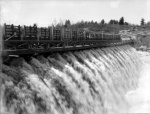 Barrage du lac Dubuc
Barrage du lac Dubuc
sur la rivière ... -
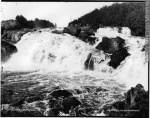 Chutes de Chicoutimi,
Chutes de Chicoutimi,
rivière Sague... -
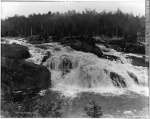 Chutes de Chicoutimi,
Chutes de Chicoutimi,
rivière Sague... -
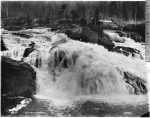 Chutes de Chicoutimi,
Chutes de Chicoutimi,
rivière Sague...
-
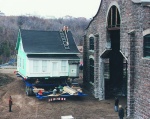 Déménagement de la ma
Déménagement de la ma
ison Arthur-Vil... -
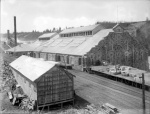 L'usine Sainte-Marie,
L'usine Sainte-Marie,
avant son agra... -
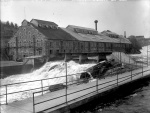 L'usine Sainte-Marie,
L'usine Sainte-Marie,
mai 1923 -
 La Pulperie de Chicou
La Pulperie de Chicou
timi, QC, copie...
-
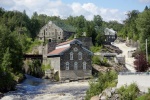 La Pulperie, de nos j
La Pulperie, de nos j
ours -
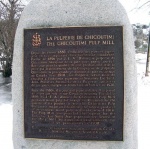 Plaque apposée par la
Plaque apposée par la
Commission des... -
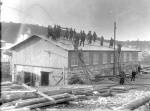 Pompiers à l'exercice
Pompiers à l'exercice
, pulperie de C... -
 Pulperie de Chicoutim
Pulperie de Chicoutim
i, rivière Sag...
-
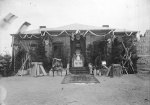 Reposoir aménagé deva
Reposoir aménagé deva
nt un bâtiment ... -
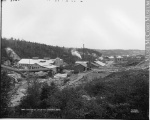 Usines de pâte, Chic
Usines de pâte, Chic
outimi, rivièr... -
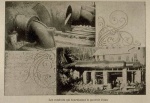 Vue des conduits qui
Vue des conduits qui
fournissent le ... -
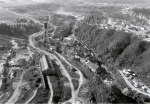 Vue du site à l'aband
Vue du site à l'aband
on (non datée)...
Documents PDF
-
 La Pulpe au Saguenay-Lac-St-Jean
La Pulpe au Saguenay-Lac-St-Jean
-
 Première annonce de la fermeture de la Quebec Pulp
Première annonce de la fermeture de la Quebec Pulp
-
 Une assemblée officialise la fermture des usines de la Quebec Pulp
Une assemblée officialise la fermture des usines de la Quebec Pulp
Hyperliens
- La Pulperie de Chicoutimi, Canada's Historic Places
- La Pulperie on the Répertoire du patrimoine culturel du Québec [French only]
- Pulperie de Chicoutimi, official website

![The Pulperie de Chicoutimi [Pulp Mill], today.](/media/thumbs/2057/300x200-pulperie_1.jpg)
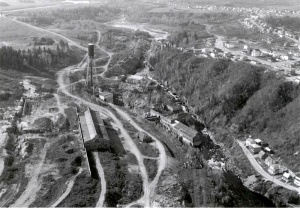
![Lac Dubuc Dam on Rivière Chicoutimi [River] at Mill no 2 (Sainte-Marie Plant), circa 1908](/media/thumbs/2064/300x229-pulperie_14.jpg)
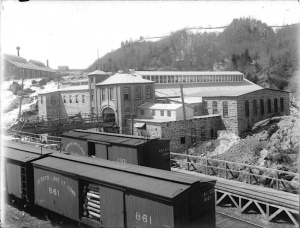
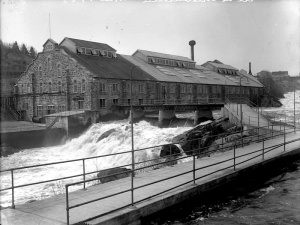
![La Pulperie de Chicoutimi [Paper Mill], Saguenay River, QC, circa 1910](/media/thumbs/2063/300x186-pulperie_13.jpg)
